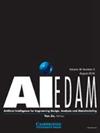高效可靠性分析的自适应超球克里格法
IF 2.3
3区 工程技术
Q3 COMPUTER SCIENCE, ARTIFICIAL INTELLIGENCE
Ai Edam-Artificial Intelligence for Engineering Design Analysis and Manufacturing
Pub Date : 2022-11-08
DOI:10.1017/S0890060422000208
引用次数: 1
摘要
摘要尽管准确的可靠性评估对于建立有弹性的基础设施至关重要,但它通常需要耗时的计算。为了减少计算负担,基于机器学习的代理模型已被广泛用于预测结构设计的失效概率。然而,代理模型仍然需要计算和评估一定数量的训练样本,以实现足够的预测精度。本文提出了一种新的可靠性分析代理方法——自适应双曲线克里格可靠性分析(AHKRA)。AHKRA方法围绕着使用基于超球的采样区域。超球的半径代表了可靠性分析的精度。基于评估具有目标变异系数的失效概率所需的样本数量,对其进行迭代调整。AHKRA采用超球采样,而不是基于n-sigma规则的采样区域,以避免维度诅咒。AHKRA在十个数学和两个实际案例中的应用验证了它的准确性、效率和鲁棒性,因为它优于以前的基于克里格的方法。本文章由计算机程序翻译,如有差异,请以英文原文为准。
Adaptive hyperball Kriging method for efficient reliability analysis
Abstract Although an accurate reliability assessment is essential to build a resilient infrastructure, it usually requires time-consuming computation. To reduce the computational burden, machine learning-based surrogate models have been used extensively to predict the probability of failure for structural designs. Nevertheless, the surrogate model still needs to compute and assess a certain number of training samples to achieve sufficient prediction accuracy. This paper proposes a new surrogate method for reliability analysis called Adaptive Hyperball Kriging Reliability Analysis (AHKRA). The AHKRA method revolves around using a hyperball-based sampling region. The radius of the hyperball represents the precision of reliability analysis. It is iteratively adjusted based on the number of samples required to evaluate the probability of failure with a target coefficient of variation. AHKRA adopts samples in a hyperball instead of an n-sigma rule-based sampling region to avoid the curse of dimensionality. The application of AHKRA in ten mathematical and two practical cases verifies its accuracy, efficiency, and robustness as it outperforms previous Kriging-based methods.
求助全文
通过发布文献求助,成功后即可免费获取论文全文。
去求助
来源期刊
CiteScore
4.40
自引率
14.30%
发文量
27
审稿时长
>12 weeks
期刊介绍:
The journal publishes original articles about significant AI theory and applications based on the most up-to-date research in all branches and phases of engineering. Suitable topics include: analysis and evaluation; selection; configuration and design; manufacturing and assembly; and concurrent engineering. Specifically, the journal is interested in the use of AI in planning, design, analysis, simulation, qualitative reasoning, spatial reasoning and graphics, manufacturing, assembly, process planning, scheduling, numerical analysis, optimization, distributed systems, multi-agent applications, cooperation, cognitive modeling, learning and creativity. AI EDAM is also interested in original, major applications of state-of-the-art knowledge-based techniques to important engineering problems.

 求助内容:
求助内容: 应助结果提醒方式:
应助结果提醒方式:


